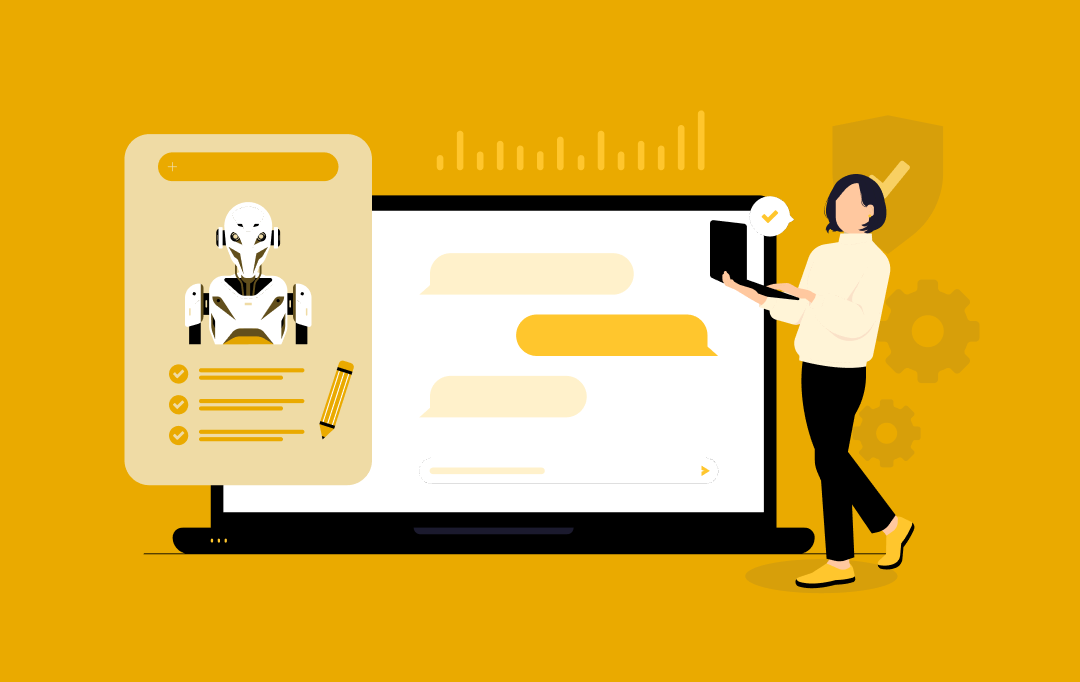- What Exactly is ChatGPT, and What is the Hype about?
- The Ever-Evolving Advancements in ChatGPT
- GPT 3 - A Milestone in Conversational AI
- ChatGPT 4 - The Next Frontier
- Code Interpreter: The Revolutionary Plugin
- ChatGPT App Development Cost: A Comprehensive Breakdown
- How Can You Optimize the Cost of Developing an App like ChatGPT?
- Choosing the Right Development Partner
- Banking on MVP Approach
- Choosing a Cloud-Based Solution
- The C-Suite's Guide to Developing a Successful AI Chatbot
- Define the business requirements
- Conduct market research
- Choose the right development partner
- Develop a minimum viable product (MVP)
- Test and refine the chatbot
- Launch the chatbot
- The Technical Process of Building a ChatGPT-Inspired Chatbot
- At Appinventiv, We Understand AI/ML
- FAQs
- Q: How much does it cost to develop an app like ChatGPT?
- Q: How much time does it take to develop an AI chatbot?
- Q: How big of a dataset is required to develop an AI chatbot?
Since its launch in November 2022, ChatGPT has shaken the technological world as we know it. The natural language processing (NLP) chatbot developed by OpenAI has shown the world how transformative artificial intelligence will be. From passing university-level exams to writing keynote speeches, from assisting marketers to helping programmers write and debug codes, no industry or domain is untouched by this AI revolution known as ChatGPT.
Moreover, with Microsoft’s recent investment in ChatGPT (the third by Microsoft since 2019), even Google has declared a ‘code red’ anticipating an existential threat to its search business monopoly. Businesses around the globe are inspired and awestruck by the prowess of ChatGPT, and most are looking to harness the technology for their organizations.
We at Appinventiv were also amazed by the ripples created by ChatGPT in the tech industry.
Therefore, in our audience’s interest, we wanted to share our expert insight into how to make an app like ChatGPT and ChatGPT app development cost, which can be anywhere between $500,000 to a few million dollars (more details later). We will also, in detail, guide you on the business and technical process of creating such a chatbot. However, before diving deep into the technical mumbo-jumbo, let us understand ChatGPT.
Also read: How much does it cost to build a text to video generator like OpenAI’s Sora
What Exactly is ChatGPT, and What is the Hype about?
In its essence, ChatGPT is a chatbot. But when you look a little bit closer, it is so much more than that. OpenAI developed a natural language processing artificial intelligence model based on ‘Generative Pre-trained Transformer 3’ (GPT 3) technology.
In its own words, “ChatGPT is a state-of-the-art language generation model developed by OpenAI. It uses deep learning techniques to generate text based on the input it receives. This allows ChatGPT to hold conversations and answer questions on a wide range of topics with high coherence and consistency.”
AI chatbots could not have human-like conversations for years, and their capabilities were limited. But this challenge has now been overcome with the advent of transfer learning (more on that in a bit) and the power to process humongous amounts of data. Hence the hype.
The Ever-Evolving Advancements in ChatGPT
OpenAI has been developing its GPT algorithm for years, the latest version being GPT 4. Let’s discover the recent developments of ChatGPT and its key milestones, such as GPT 3, GPT 4, and the Code Interpreter plugin.
GPT 3 – A Milestone in Conversational AI
OpenAI trained the first version of GPT with the objective of causal language modeling (CLM) being able to predict the next token in a sequence. Building upon this model, GPT 2 could generate coherent text from a grammatical and linguistic standpoint. Then came GPT 3, on which ChatGPT is based. GPT 3 has gained worldwide traction with its immense capabilities to generate human-like text with exceptional coherence and understanding. This conversational AI chatbot became an internet sensation overnight and had 1 million users in just five days and 10 million in 40 days since its launch on 30th November 2022.
ChatGPT 4 – The Next Frontier
Witnessing the tremendous success of GPT 3, OpenAI released ChatGPT 4 on March 14, 2023, which is available via API and for premium ChatGPT users. GPT 4 has taken the concept of AI chatbots to an entirely new level. It has further refined language generation capabilities, exhibiting improved context awareness and even more accurate responses. This version demonstrated remarkable progress in understanding complex queries and delivering relevant answers, solidifying its position as one of the most advanced language models to date.

Code Interpreter: The Revolutionary Plugin
Taking the concept of a chatbot to unprecedented heights, OpenAI introduced a game-changing feature – the Code Interpreter plugin on July 6th, 2023, available for ChatGPT Plus users. This plugin is not just a step forward; but a quantum leap in the capabilities of ChatGPT. Greatest of all plugins that enhance AI capabilities, Code Interpreter allows users to create charts, edit HTML files, visualize data, write codes, and perform mathematical operations. In short, it is like a personal data scientist that helps you analyze complex data and provide actionable insights.
From GPT 3 to ChatGPT 4 and Code Interpreter plugin, ChatGPT has evolved into a powerful tool through each milestone, redefining the possibilities of human-AI interactions. The rapid growth of ChatGPT is showing no sign of slowing down. Even OpenAI plans to introduce new features in 2024, such as video chat, voice chat, virtual assistants, e-commerce solutions, and social media integration.
ChatGPT App Development Cost: A Comprehensive Breakdown

Several factors will determine GPT-based app development costs. The complexity of the model, the end use case of the model, the dataset required, and the computational requirements are some of the significant factors that will influence the cost of developing a ChatGPT-like AI app. To have a sense of the dataset required, ChatGPT was trained on 570GB of textual data.
To begin with, gathering a large dataset can be quite expensive, especially if you need to pay for access to proprietary data or hire people to annotate the data. Additionally, if you have to use cloud-based resources, the cost to develop an app like ChatGPT can be quite high depending on the resources used and the duration of usage. The cost of data annotation ranges from a few cents per annotation to a few dollars per annotation. Also, the cost of obtaining data can vary greatly depending on the source.
[Also Read: How Much Does It Cost to Build an AI Chatbot App Like Ask AI]
From a storage and computational standpoint, if you use cloud-based resources like AWS, GCP, or Azure, the cost to develop an app like ChatGPT ranges from a few hundred dollars per month to several thousand dollars per month, depending on the resources used and the duration of usage. Additionally, creating an interface or app will also add to AI-based app development costs.
To put a number to it, the ChatGPT app development cost can range between $500,000 to a few million dollars. And it can take from several months to over a year to develop such an app, depending on the factors mentioned above. The cost of developing an AI content detection tool is also around the same range.
[Also Read: How Much Does It Cost to Develop a Tool Like Jasper AI?]
How Can You Optimize the Cost of Developing an App like ChatGPT?
Developing an artificial intelligence chatbot is difficult and requires the expertise of unmatched caliber. However, ChatGPT app development cost can be optimized by making strategic decisions. Here are a few ways to optimize the cost of developing an app like ChatGPT.
Choosing the Right Development Partner
The right custom mobile app development services partner will not only help you create a reliable and technologically-sound product but will also help you save costs by avoiding mistakes, rework, and budget overruns. The right development partner (like Appinventiv) will deeply understand the latest technologies and can help optimize ChatGPT app development costs.
Banking on MVP Approach
MVP or a minimum viable product is a development approach where the core features of an app or software are first developed and released for feedback. The MVP foundation features are built as per the requirement of the customers. This approach saves AI-based app development costs by only adding the features that customers want and use, eliminating any unnecessary feature costs.
[Also Read: How Much Does It Cost to Build an AI App Like DeepSeek?]
Choosing a Cloud-Based Solution
By Now, almost every business is aware that moving to the cloud is a low-hanging cost optimization strategy. This holds in the case of an AI chatbot as well. Because of the huge amount of data required to train and operate such a chatbot, partnering with a cloud provider can further reduce the cost to develop an app like ChatGPT.
[All you need to know about cloud-based app development]
The C-Suite’s Guide to Developing a Successful AI Chatbot
As a business leader, it is vital to understand the strategic path you’ll have to take when making an app like ChatGPT. Here is a snapshot of the process that will lead you to create a smashing chatbot.
Define the business requirements
Goes without saying the first thing you’ll do is define the business requirements and the objective of the chatbot. While doing this, the things to consider are the target audience, the goals of the chatbot, the key features, and the budget for the project.
Conduct market research
The next step in creating an app like ChatGPT will have you conducting thorough market research to identify the competitive landscape and to understand the current state of AI chatbots in the market. This will help to ensure that the developed chatbot is competitive and meets the target audience’s needs.
Choose the right development partner
Now that you are all set to build an app like ChatGPT, you’ll want to zero in on a development agency that can accomplish this task. Understanding AI/ML, a robust portfolio, and an impressive clientele list are some things you would consider while choosing the agency.
Develop a minimum viable product (MVP)
The next milestone would be to develop an MVP that includes the core features of the chatbot. This will allow the development team to get feedback from users early in the process and to make changes to the chatbot as needed and adding more ChatGPT features on the way.
Test and refine the chatbot
After the development of an MVP, will come rigorous testing and fine-tuning. Test the chatbot with a small group of users to identify any issues and gather feedback. Based on the feedback received, make any necessary refinements to the chatbot.
Launch the chatbot
After testing and refining the model, it is time for you to release the ChatGPT-like chatbot mobile app into the open market. However, monitoring its performance and gathering user feedback is crucial to identify any additional refinements that may be needed.
The GPT-powered chatbot app creation process is vast and requires entrepreneurial expertise and exceptional skills. Let us now understand the technicalities of a ChatGPT-like app development process.
Also Read: Unlocking the Potential of ChatGPT to Enhance DevOps Workflow
The Technical Process of Building a ChatGPT-Inspired Chatbot

Since ChatGPT is an AI/ML-based chatbot, the process will involve training an AI model. Here is a step-by-step breakdown.
1. The very first step in building an app like ChatGPT will be to gather a dataset that resembles the output you want from the model. The dataset is recommended to be diverse and cover various topics and styles, including conversational and written text. To ensure high performance and accuracy, it is best to use a pre-existing language model that has already been trained on a large corpus of text data and then fine-tune it for your specific use case.
There are many such open-source datasets available on the internet. One such is the GloVe by Stanford, which allows users to train learning algorithms for obtaining vector representations for words. Vector representation of words is a method in NLP where words are represented as numerical vectors (also known as word embeddings).
These vectors capture the semantic and syntactic meaning of the words in a continuous, multi-dimensional space. This representation enables NLP models to perform mathematical operations on words, such as comparison and clustering, that would be difficult or impossible to do with traditional methods. The vectors can be generated using various algorithms such as word2vec, GloVe, and FastText.
2. The next step in building an app like ChatGPT will be to fine-tune the pre-trained language model to become conversational using the Transfer Learning technique. Transfer learning is a relatively new method that was first introduced in the early 2000s. A powerful concept in deep learning transfer learning is a technique that allows a model trained on one task to be used for another task. Transfer learning works by taking a model that has already been trained on a large dataset and then adapting it to a new task. This means that the model can be used to solve a new problem without training it from scratch. This saves time and resources, as the model already has knowledge of the task it was trained on.
A straightforward way to perform transfer learning is to use the output of one model as input to another model. For example, a model trained to perform a natural language processing task, such as language translation, can be used as the input to another model that is trained to perform a different natural language processing task, such as text summarization. This can allow the second model to take advantage of the language understanding learned by the first model.
In its essence, transfer learning is exactly what its name suggests, to transfer the learning of the first model to the next, and so on, increasing the accuracy of the model exponentially each time.
3. The next step is fairly easy and will require you to build an interface or an app that will harness the model, will receive inputs from the users, and, based on the inputs, will deliver the output. This interface can take the form of a web-based application, such as ChatGPT, a ChatGPT mobile app, or even a messaging platform. The applications of such a model are virtually limitless.
Once you have integrated the model into a ChatGPT mobile app via APIs, you must test and fine-tune the model further.
[Also Read: How ChatGPT integration helps an enterprise business improve its operations]
At Appinventiv, We Understand AI/ML
Being at the forefront of the technological revolution, we have helped numerous clients achieve scale and agility, harnessing the data that used to be trapped in silos with our AI development services.
From harnessing AI capabilities to develop a budget management application to using artificial intelligence to streamline and optimize the day-to-day operations of a leading European bank, our teams of data scientists and engineers have outshined time and again.
Now that artificial intelligence and machine learning are on to reshaping the biz-tech landscape as we know it, generative AI consulting is a vital resource to consider. It is time to use artificial intelligence to your advantage. Connect with us and discuss your generative AI chatbot requirements today.
FAQs
Q: How much does it cost to develop an app like ChatGPT?
A: ChatGPT app development costs can range anywhere between $500,000 to a few million dollars. The factors that affect the cost are the dataset’s size, the chatbot’s end-use case, the services, the features required, etc.
Q: How much time does it take to develop an AI chatbot?
A: Depending on the factors mentioned above, developing an AI chatbot can take several weeks to months.
Q: How big of a dataset is required to develop an AI chatbot?
A: The dataset size varies with the chatbot’s intended application. To give a general idea, ChatGPT was trained on a textual dataset of 570GB.


- In just 2 mins you will get a response
- Your idea is 100% protected by our Non Disclosure Agreement.

How to Integrate AI with EHR/EMR Systems for Streamlined Healthcare Operations
Key takeaways: Not adopting AI in EHR/EMR today risks falling behind. AI streamlines EHR workflows, cutting clinical and admin delays. Real-world hospitals are already seeing faster, smarter care with AI. Seamless AI integration needs system checks, data prep, and training. AI in EHR tackles real challenges like bias, cost, and compliance. Custom AI integration costs…

AI Agent-Driven UIs: Replacing App Menus and Buttons
Key takeaways: Challenge: Static menus and buttons also become outdated because people are frustrated by limited, multi-stage navigation. Solution: The AI Agent interacts with the user through a friendly UI that does not require cludgy menus but conversational and context-sensitive navigation. The Way AI Agents Work: AI agents establish a basis of natural language understanding,…

10 Use Cases and Benefits of How AI Agents Are Revolutionizing the Retail Industry
Key takeaways: AI agents in the retail industry are revolutionizing businesses by enhancing customer experience and streamlining operations. From personalized recommendations to predictive analytics, AI offers tangible benefits like increased conversions and reduced costs. AI adoption can lead to scalable growth and a competitive edge in the retail industry. Retailers must consider data strategies, talent…


















